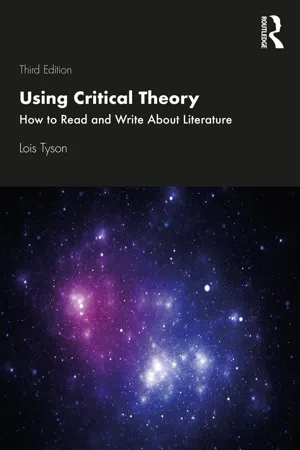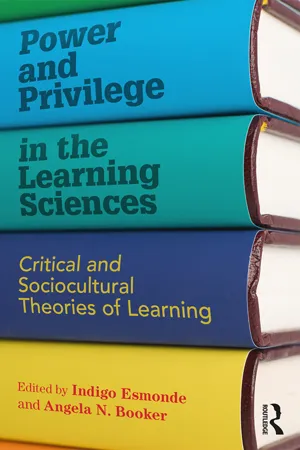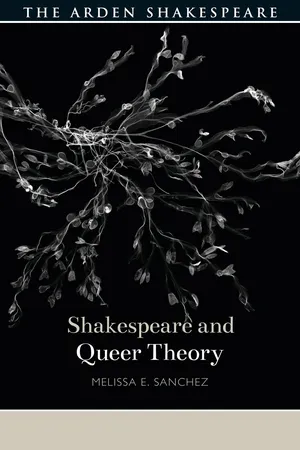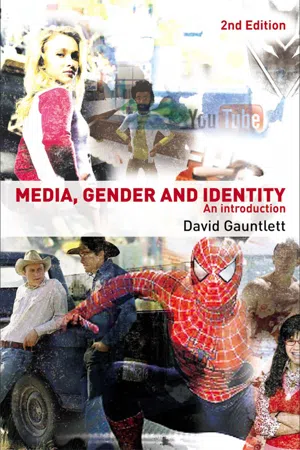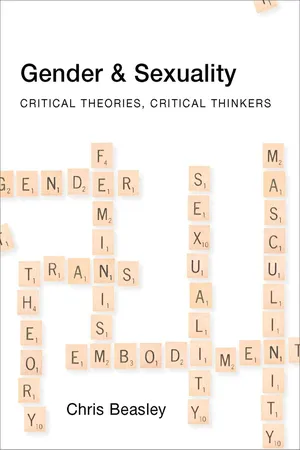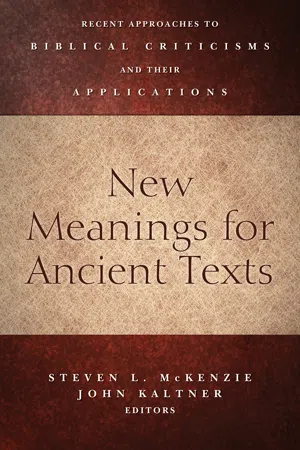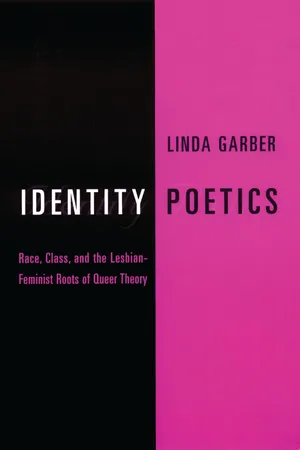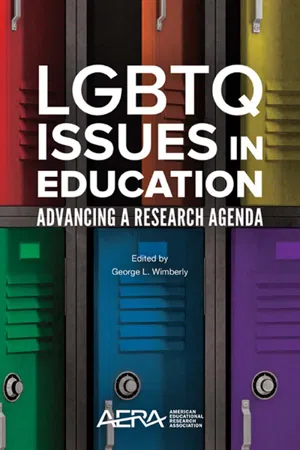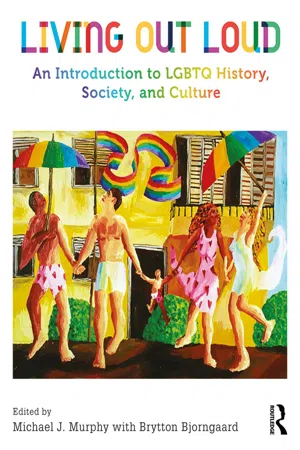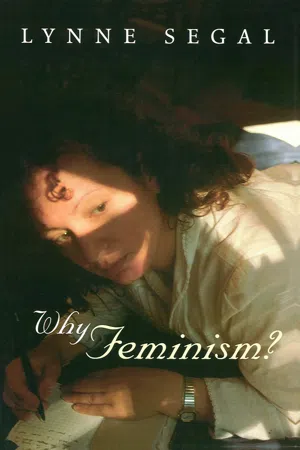Literature
Queer Theory
Queer Theory is a critical framework that challenges traditional notions of gender and sexuality. It seeks to deconstruct and analyze the social constructs that define and regulate these identities, as well as the power dynamics at play. In literature, Queer Theory is used to examine how LGBTQ+ themes and characters are represented and to explore the intersection of sexuality, gender, and identity.
Written by Perlego with AI-assistance
Related key terms
Related key terms
1 of 4
Related key terms
1 of 3
12 Key excerpts on "Queer Theory"
- eBook - ePub
Using Critical Theory
How to Read and Write About Literature
- Lois Tyson(Author)
- 2020(Publication Date)
- Routledge(Publisher)
Homoerotic imagery consists of erotic (though not necessarily overtly sexual) visual images that imply same-sex attraction or that might appeal sexually to a same-sex reader. For example, a lush, sensual depiction of a group of women helping one another undress or of nude men bathing in a beautiful pond would be considered homoerotic. We can find many homoerotic images in literature—Walt Whitman’s are especially well known—as well as in, for instance, painting, sculpture, film, and photography.Queer Theory
Some LGBT people have adopted the word queer to refer to themselves for a number of reasons. Referring to themselves positively with a word that has been used to insult them is a way of taking power away from heterosexist society, a way of saying, “We’re proud that we’re different, and we’re not going to be intimidated by heterosexism.” In addition, the word queer is used positively as a broad, inclusive category that acknowledges the shared political and social experience of lesbian, gay, bisexual, transgender, and all people who consider themselves, for whatever reasons, not heterosexual. The inclusive initials, therefore, are LGBTQ. Finally, and most important for our interpretation of literature, the word queer is used to indicate a specific theoretical perspective, in frequent use today, called Queer Theory.Queer Theory argues that human sexuality cannot be understood by such simple opposed categories as homosexual and heterosexual, which define our sexuality by the sex of our sexual partner and nothing more.4 - eBook - ePub
Power and Privilege in the Learning Sciences
Critical and Sociocultural Theories of Learning
- Indigo Esmonde, Angela N. Booker, Indigo Esmonde, Angela N. Booker(Authors)
- 2016(Publication Date)
- Routledge(Publisher)
Queerness, then, became a tool for investigating assumptions about what constitutes the “normal” in society and in everyday life. The forms of inquiry and theories that emerged in this area have been clustered, more or less loosely, under the term “Queer Theory.” Queer Theory not only rejects the framing of queerness as a lack of something (as seen in, for example, the term “non-heterosexuality”), but it also reframes queerness as a presence —of desire, of subversive social or political leanings, of relationships (sexual or not) that are not recognized by, and therefore are not legible to, governmental or other institutions (Butler, 2004; Dilley, 1999; Jagose, 1996). All of the above are examples of how this perspective aims to queer dominant assumptions, theories, and social practices: In other words, to challenge what constitutes normalcy and to offer alternative ways of thinking and acting in the world. Queer Theory shares much common ground with sociocultural theories of human action and learning. As sociocultural theories do, a queer framework takes an interest in how particular ideas, roles, and actions come to be taken as normative within valued cultural practices, as well as in how norms and practices are reproduced or resisted as people interact with cultural artifacts and each other (Berlant & Warner, 1995; Dilley, 1999; Engeström, 1987; Green, 2007; Kaptelinin & Nardi, 2006; Kozulin, 1986). Sociocultural theories treat cognition as distributed across mind, body, activity, and context (Packer & Goicoechea, 2000) and aim to develop theories of learning that account for the historically and culturally valued practices that shape and are shaped by individuals’ participation in communities of practice (Lave, 2012; Sannino, Daniels, & Gutiérrez, 2009; Stetsenko & Arievitch, 2004; Wertsch, 2005). Queer Theory, however, approaches the sociocultural dimensions of knowledge and action from a somewhat different ontological and epistemological standpoint - eBook - ePub
- Melissa E. Sanchez, Evelyn Gajowski(Authors)
- 2019(Publication Date)
- The Arden Shakespeare(Publisher)
(1993: xxvi) Queer Theory, in other words, maintains that securing a just and safe world for sexual minorities requires critique of the very concepts of the normal, the private and the political. This means beginning from the premise that the subject of queer politics is neither knowable nor namable in advance. Whereas gay and lesbian studies generally focus on the history and significance of the homosexual–heterosexual distinction, Queer Theory examines the relation between queerness and normativity. Because gender of object choice was (and is) the most visible dimension of normativity, gay and lesbian and queer analysis often converge. But as I noted in the introduction, a (perhaps the) signal intervention of Queer Theory is to differentiate heterosexuality (which I’ll define as desire for genital contact exclusively with members of the opposite sex assignment) from heteronormativity (the idea that heterosexual desire is uniquely natural and healthy). As Berlant and Warner explain, Queer Theory allows us to see that heterosexuality’s ‘coherence is always provisional, and its privilege can take several (sometimes contradictory) forms … Contexts that have little visible relation to sex practice, such as life narrative and generational identity, can be heteronormative in this sense, while in other contexts forms of sex between men and women might not be heteronormative’ (1998: 548, n. 2, original emphasis). Berlant and Warner vividly illustrate the distinction between heterosexuality and heteronormativity by describing a leather-bar performance of erotic vomiting. ‘A boy, twentyish, very skateboard, comes on the low stage at one end of the bar, wearing lyrca shorts and a dog collar’ and ‘sits loosely in a restraining chair’; his (male) partner slowly force-feeds him, keeping him just ‘at the threshold of gagging’ - eBook - ePub
Contemporary Literary and Cultural Theory
An Overview
- Jeffrey R. Di Leo(Author)
- 2023(Publication Date)
- Bloomsbury Academic(Publisher)
Fear of a Queer Planet (1993), Michael Warner argues that“queer” represents, among other things, an aggressive impulse of generalization; it rejects a minoritizing logic of toleration or simple political interest-representation in favor of a more thorough resistance to regimes of the normal … For both academics and activists, “queer” gets a critical edge by defining itself against the normal rather than the heterosexual.21In short, by the 1990s, Queer Theory comes to replace gender theory as the preferred general term for critical inquiry into sex and sexuality. The term Queer Theory was first used by Teresa de Lauretis at a conference at the University of California, Santa Cruz, about lesbian and gay sexualities in 1990. Her aim was to create some critical distance between the gay and lesbian studies, which emerged in the 1970s, and to emphasize the study of gay and lesbian sexualities in their own right instead of as deviations of heterosexuality.22 For both de Lauretis and Warner, Queer Theory is about resistance to regimes of the normal and counteracting discourse that normalize the heterosexual.Today, however, while Queer Theory is still widely used, LGBTQ+ theory is perhaps an even more inclusive designation for the work that is currently being done in literary and cultural analysis regarding sexual orientation and gender identity. LGBTQ+ theory encompasses a broad range of perspectives on sex and sexuality including gay and lesbian theory (7.1), lesbian feminism (7.2), Judith Butler’s theory of gender performativity (7.3), the trans* theory of Jack Halberstam (7.5), and the queer affect theory of Eve Kosofsky Sedgwick (7.4). In addition to these topics, which are all covered in this chapter, LGBTQ+ theory also intersects in various ways with broader issues in race and justice (8.0), biopolitics (9.0), globalization (10.0), posthumanism (12.0), affect studies (13.0), and pop culture - eBook - ePub
Media, Gender and Identity
An Introduction
- David Gauntlett(Author)
- 2008(Publication Date)
- Routledge(Publisher)
Gender Trouble by Judith Butler. (Also important, within the version of Queer Theory which is concerned with literature rather than social identities, is the work of Eve Kosofsky Sedgwick, which challenges assumptions about sexuality in literature.)Figure 7.1 Judith ButlerIt is also worth mentioning that Butler is unlikely to win any awards for clarity of writing style. (On the contrary, indeed, she once won an annual international award for having produced the most incomprehensible academic text.) Her prose is unnecessarily dense and long-winded, and almost never fails to use jargon even where much more accessible vocabulary is available. Some people defend this, saying that academics should be allowed to develop complex terminology to express their sophisticated ideas – after all, nobody expects to read journals about rocket science and understand all of it straight away. However, although Butler’s writing is like an explosion in a dictionary factory, if one takes time to dig through the rubble one finds that her ideas are actually quite straightforward. So let’s get started.Queer Theory SUMMARY
We’ll need to look at each of these points in more detail to fully understand their meaning and implications, but here’s the simple summary of what Queer Theory is about:- Nothing within your identity is fixed.
- Your identity is little more than a pile of (social and cultural) things which you have previously expressed, or which have been said about you.
- There is not really an ‘inner self’. We come to believe we have one through the repetition of discourses about it.
- Gender, like other aspects of identity, is a performance (though not necessarily a consciously chosen one). Again, this is reinforced through repetition.
- eBook - ePub
Gender and Sexuality
Critical Theories, Critical Thinkers
- Chris Beasley(Author)
- 2005(Publication Date)
- SAGE Publications Ltd(Publisher)
The etymological (terminological) history of the broad usage of ‘queer’ can be viewed as representing shifts in the conceptualisation of non-heterosexual sex, especially of same-sex sex. Just as the term ‘homosexual’ was overtaken by ‘gay’ and then by ‘gay and lesbian’ from the 1960s and 1970s, so too ‘queer’ has now become the word of the day. A term like ‘gay’ aimed to transform the solely sexual and pathological descriptor ‘homosexual’ by drawing upon light-hearted notions of carefree joy and nineteenth-century slang regarding women of doubtful morals (Jagose, 1996: 73; Cranny-Francis et al., 2003: 75). By contrast, the history of the term ‘queer’ is far less positive. A tougher, less jokey label, it draws upon a long history of mostly abusive use from at least the early twentieth century. Indeed, this negative history means that it remains, for some, a controversial term (Cranny-Francis et al., 2003: 75). However, the term does not just signal a new use of a term on an old subject. Jeffrey Weeks (1977: 3) notes that such shifts in terms also point to changing understandings and changing socio-political conditions. ‘Queer Theory’ refers in this context, according to Jagose (1996: 76), to transformations in theory and politics around the late 1980s and early 1990s (see also Walters, 2001: 12659–61).The term ‘Queer Theory’ entered theoretical discussion in the early 1990s. Teresa de Lauretis coined it in her introduction to the lesbian and gay issue of the journal differences in 1991 (Andermahr et al., 2000: 220). She refers to the ‘necessary critical work of deconstructing our own discourses and [what they silence]’ (de Lauretis, 1991: v). Here Queer Theory is aligned with anti-essentialism and the Postmodern turn in theorising. In particular, according to Jagose’s (1996: 98) widely used characterisation, Queer ‘marks a suspension of identity as something fixed, coherent and natural’. Queer Theory, she says, opts for denaturalisation as its primary strategy and indicates ‘a critical distance from … identity politics’ (Ibid.; Cranny-Francis et al., 2003: 75). Queer involves both a ‘challenge to the notion of unitary identity (as in “gay” or “straight”)’ and ‘a rejection of binary models (gay/straight, man/woman)’, leading to ‘a more generic critique of identity-based theories and politics’ (Walters, 2001: 12659, emphasis added). Such identity-based agendas are seen as invariably reproducing the silencing exclusionary practices of power that they precisely arose to resist. This critique of identity is accompanied by a constructive stress on multiplicity, fluidity and instability . As Joseph Bristow and Angela Wilson (1993: 1–2) put it, ‘an erstwhile politics of identity has largely been superseded by a politics of difference’. Differences, - eBook - ePub
New Meanings for Ancient Texts
Recent Approaches to Biblical Criticisms and Their Applications
- Steven L. McKenzie, John Kaltner(Authors)
- 2013(Publication Date)
- Westminster John Knox Press(Publisher)
2 It would not be quite right to call the resulting queer criticism a method, if by method one means a set of agreed upon steps that reliably lead disciplined readers to shared conclusions. However, queer criticism can be understood as a kind of interpretive sensibility or style of reading, which shapes particular interpretations of texts to varying degrees.Although it will be important to keep in mind the heterogeneity of queer commentary that Berlant and Warner emphasize, in this chapter the most significant characteristics of queer criticism include the following:- Queer criticism calls attention to sexual practice and gender, often in relation to one another, as key sites for the interpretation of cultural, social, and textual meanings and practices.
- Queer criticism emphasizes the fact that meanings and practices associated with sex, gender, and kinship vary significantly across cultures and histories, or even within a single culture. This emphasis contrasts with all attempts to stabilize the meanings and practices associated with sex, gender, or kinship by grounding them in a supposedly unchanging nature, assumed cultural universals, or religious revelation.
- Working under the influence of thinkers and ideas associated with “Queer Theory,” queer criticism tends to be suspicious of organizing sexual and gender meanings too rigidly around stable binary oppositions such as male and female, masculine and feminine, or heterosexual and homosexual. Instead, queer criticism emphasizes the fluidity and unpredictability of gender, sexual desire, and sexual practice, as well as the instability of the binary oppositions that are thought to structure them.
- The tendency for readers (including scholars) to universalize a particular set of modern, Western norms for sexual practice, gender roles, and family structures is analyzed critically by queer criticism as “heteronormative.” At its most basic, “heteronormativity” is the institutionalized preference for opposite-sex sexual relationships over same-sex sexual relationships. However, a number of other assumptions and practices are also associated with heteronormativity, including the beliefs that binary gender roles follow naturally from biological sex; that sexual desire and sexual practice follow from gender roles and/or biological sex; that an individual’s biological sex, gender roles, sexual desires, or sexual practices are consistent over time; that kinship units ideally form around a monogamous, opposite-sex couple; and that sexual activity is most appropriately aimed at romantic love, reproduction, and childbirth. Although heteronormativity may appear to be self-evidently good to its supporters, queer criticism notes that heteronormativity often leads to the marginalization or persecution of individuals and populations who fall short of its ideals.
- eBook - ePub
Sexuality
A Psychosocial Manifesto
- Katherine Johnson(Author)
- 2015(Publication Date)
- Polity(Publisher)
348). For many within Queer Theory this could be interpreted as ‘unqueer’, writing a stable ‘queer identity’ into his reading of the way queer commentaries challenge notions of identity. Although these favour disrupting and delegitimizing ‘heteronormative knowledges and institutions, and the subjectivities and socialities that are (in)formed by them and that (in)form them’ (Sullivan, 2003, p. vi), queer readings also signify that identity is messy, and ‘that desire and thus desiring subjects cannot be placed into discrete identity categories, which remain static for the duration of people’s lives’ (Giffney, 2009, p. 2). Thus, adventures into the territory of ‘queer’ extend the social constructionist trajectory of instability in truth that critical psychologists are familiar with but shift it into a more emphatic dismantling of identity categories. Queer was not meant to name a new identity category, rather to signify a movement or approach that requires us to take an actively anti-homophobic stance by uncoupling sexuality, desire and sexual practices from identity. Nevertheless, this raises challenges for psychologists, even those working within critical or community perspectives, because the object of study for psychology is norms of behaviour, and the subject of research is, most often, the individual, conceived as having agency and a sense of self (whether through social interaction or biology) - eBook - ePub
Identity Poetics
Race, Class, and the Lesbian-Feminist Roots of Queer Theory
- Linda Garber(Author)
- 2001(Publication Date)
- Columbia University Press(Publisher)
Queer Studies seems at present to have wrested the hegemonic mantle from gay and lesbian studies because it comes closer to employing the language and perspective of poststructuralism that has currency in the academy. Therefore, it is likely that graduate students with an interest in the discipline will feel constrained to do Queer Theory rather than any other approach to gay and lesbian studies. (“Preface,” 12)As the marginal moves to the center, dissident voices are once again suppressed. By this I mean not only lesbian feminism, or “lesbian and gay studies,” but also the variety of “non-theorists”—working-class/lesbians of color, poets, community organizers—whose presence disrupts both the rise to institutional power and the false dichotomy queer/lesbian-feminist that functions as definitional to Queer Theory and politics. Farwell points out the irony in a postmodern criticism seeing itself as part of “a grand … narrative of liberation that obscures lesbian-feminist thought” (Heterosexual Plots, 107); a simple deconstruction exposes a similar irony in positing only two, dramatically opposed, possibilities for lesbian theory.Queer theorists seem uncomfortable with the move from being disrupters (Roof, Lure, 224) of “normal business in the academy” (Warner, “From Queer,” 18) to their “‘virtual deification’” (Watney on Butler, in Warner, “From Queer,” 19). Butler attempts to shed the mantle of academic power that has been bestowed upon her:I do not understand the notion of “theory,” and am hardly interested in being cast as its defender, much less in being signified as part of an elite gay/lesbian theory crowd that seeks to establish the legitimacy and domestication of gay/lesbian studies within the academy. Is there a pregiven distinction between theory, politics, culture, media? How do those divisions operate to quell a certain intertextual writing that might well generate wholly different epistemic maps? (Butler, “Imitation,” 14) - eBook - ePub
- George Wimberly(Author)
- 2015(Publication Date)
- American Educational Research Association(Publisher)
These discriminatory effects on schooling are found even when the political or policy fight over sexuality is not overtly connected to schools or those who work or learn within them. This occurs in three ways. First, purity campaigns and moral panics over the corruption of school-aged children have been endemic to efforts to regulate sexuality and constrain LGBTQ rights in areas such as sexual relations, marriage, and the military (Herdt, 2009). Second, stigmatization and criminalization of queer identity have led to concrete forms of discrimination in the everyday (school) lives of LGBTQ educators, parents, and students and their allies. Third, a combination of this regulation and discrimination has led to institutionalized forms of invisibility, rendering absent LGBTQ people who exist within the school community. Recent sociolegal changes have begun to address these concerns; we highlight them throughout this chapter.A note on terminology: We use the term queer throughout to mean individuals who have been perceived by society or have considered themselves to be lesbian, gay, bisexual, transgender, transsexual, intersexual, queer and/or questioning. We acknowledge that this term is a “recovered slur” and that, as such, its use is troublesome. We also use queer as normative—with nonqueers, who are more commonly known as heterosexuals and/or gender-conforming persons, considered to be somewhat lacking. While perhaps jarring for the uninitiated, both “queer” and “nonqueer” are linguistically consistent with the theoretical lens that we employ for this chapter—the lens of Queer Legal Theory (QLT) (Hutchinson, 1997, 1999; Valdes, 1995, 1997, 2004). Below we analyze the politics of public policy related to such regulated, criminalized, and stigmatized identities while also identifying the conditions that sustain or challenge the bias against LGBTQ people and issues in U.S. schools. We draw on QLT as an overarching framework in which these trends may be understood and through which future research may be imagined.A Brief Discussion of Queer Legal TheoryQueer Legal Theory1 - eBook - ePub
Living Out Loud
An Introduction to LGBTQ History, Society, and Culture
- Michael Murphy, Brytton Bjorngaard, Michael J. Murphy, Brytton Bjorngaard(Authors)
- 2018(Publication Date)
- Routledge(Publisher)
The History of Sexuality (1978), scholars began to think about sexuality not as an inherent biological or psychological trait, but as the result of power working through social institutions and discourse (like language and visual representations). The field shifted from thinking about homosexuals and homosexuality as historical facts that needed to be identified, recovered, described, and analyzed. Rather, scholars began to consider how all sexuality was produced, managed, and policed in society. This shift is marked by the, so-called, essentialism vs. social constructivism debate. Essentialists argued that, because same-sex desire and sexual behavior exists throughout time and in every known culture, homosexuality and the homosexual are universal phenomena. Constructivists, on the other hand, cited evidence that sexualities and sexual identities vary historically and cross-culturally, arguing that homosexuality is not innate but socially constructed—produced in unique social, cultural, and historical contexts. Queer studies became an increasingly popular name for the field as it underwent this intellectual shift and developed a body of thought often described as Queer Theory (Jagose, 1996). The emergence of queer studies also facilitated a more inclusive study of sexual identities and behaviors, including more sophisticated thinking about bisexual behavior and the burgeoning sub-field of transgender studies (Ochs & Rowley, 2005; Stryker & Whittle, 2006).Donald L. Opitz Queering Curriculum in Higher EducationCollege and university graduate students and professors are responsible for producing most of the research and writing about Queer Theory and LGBTQ+ issues in education. However, this work has not resulted in substantial curricular changes (Renn, 2010). Some schools have majors in LGBT or queer studies and, more commonly, gender or sexuality studies, but this is not the norm. Moreover, some institutions struggle to maintain these established majors (Seitz, 2009; Lindeman, 2013). Much like the way LGBTQ+ practices break heteronormative and cisnormative expectations of gender and sexuality, queer studies majors and programs require faculty and students to work across boundaries between subjects. The hierarchical organization of higher education, with departments and programs operating in isolation, creates challenges for teachers who wish to work across subject areas and create innovative approaches at the heart of queer studies (Renn, 2010). Still, some faculty traverse boundaries between fields such as the social sciences, sciences, humanities, and professional degree programs to teach and build knowledge about LGBTQ+ experiences, practices, and communities (Whitlock, 2010). At its most basic level, without crossing boundaries of formally established programs, queering the curriculum within higher education involves incorporating LGBTQ+ - eBook - ePub
Why Feminism?
Gender, Psychology, Politics
- Lynne Segal(Author)
- 2015(Publication Date)
- Polity(Publisher)
104However, it could be argued that the more tenuous ties of Queer Theory’s symbolic politics to more traditional political practices, and even the recuperability of its transgressive representations by market forces or hegemonic reframings are, in themselves, unfortunate only to the extent that they stand alone as a politics. There is no intrinsic imperative to prevent multiple political engagements, other than the tendency of more aesthetic traditions to display a disdainful detachment from the inevitably compromising work of coalition (or even subcultural) building. It is a graver problem if, on its own terrain, queer perspectives miscontrue the punitive and restrictive production and regulation of gender and sexuality. Yet I suspect that this is the case. Queer Theory’s semiotically driven reflections rarely address the ways in which, throughout our lifetimes, we move in and out of the identifications, pleasures and vulnerabilities of gender settlements, structures of desire, and management of bodily capabilities: health, age and a myriad other belongings and exclusions play a central role. We are never simply subject to (or in rebellion against) sexual and gender norms or normativities. Against Foucauldian framings, the complexity of both psychic life and bodily investments are not homologous with polarizing gender discourses, or the social injunctions which render them intelligible. On the one hand, psychic life has an autonomous complexity which sexual difference, or gender identity, does not exhaust – however firmly or precariously experienced at conscious and unconscious levels. It is never fixed or even consistent in its manifestations. On the other hand, the external namings and rules which solicit gender and sexual performativity are not themselves seamless and unchanging. It is here that I would return to the work of certain feminist clinicians critically rethinking psychoanalysis as ‘the discipline most practiced in the art of uncertainty’, as the New York analyst Virginia Goldner put it.105
Index pages curate the most relevant extracts from our library of academic textbooks. They’ve been created using an in-house natural language model (NLM), each adding context and meaning to key research topics.
Explore more topic indexes
Explore more topic indexes
1 of 6
Explore more topic indexes
1 of 4
